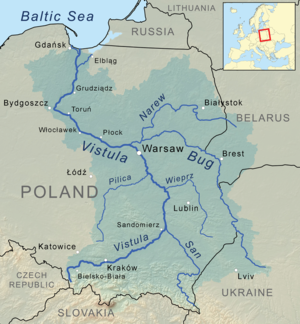Vistula
Vistula (विस्तुला नदी) is the longest and largest river in Poland. The drainage basin area of the Vistula lies within Poland (54% of its land area) and the remainder is in Belarus, Ukraine and Slovakia.
Variants of name
- Bisula
- Istula
- Vistula River
- Viscla (Jordanes)
- Wistla (William Napier)
- Ouistoula (Ptolemy)
- Wisła [ˈvʲiswa] (Polish)
- Weichsel [ˈvaɪksl̩] (German)
- Wießel (Low German)
- Yiddish: ווייסל Yiddish pronunciation: [vajsl̩]),
- Висла (Russian)
- Vandalus
Course
The Vistula rises at Barania Góra in the south of Poland, 1,220 meters above sea level in the Silesian Beskids (western part of Carpathian Mountains), where it begins with the White Little Vistula (Biała Wisełka) and the Black Little Vistula (Czarna Wisełka).[1] It then continues to flow over the vast Polish plains, passing several large Polish cities along its way, including Kraków, Sandomierz, Warsaw, Płock, Włocławek, Toruń, Bydgoszcz, Świecie, Grudziądz, Tczew and Gdańsk. It empties into the Vistula Lagoon (Zalew Wiślany) or directly into the Gdańsk Bay of the Baltic Sea with a delta and several branches (Leniwka, Przekop, Śmiała Wisła, Martwa Wisła, Nogat and Szkarpawa).
Etymology
The name was first recorded by Pomponius Mela in AD 40 and by Pliny in AD 77 in his Natural History. Mela names the river Vistula (3.33), Pliny uses Vistla (4.81, 4.97, 4.100). The root of the name Vistula is Indo-European *u̯eis- 'to ooze, flow slowly' (cf. Sanskrit अवेषन् / aveṣan 'they flowed', Old Norse veisa 'slime') and is found in many European rivernames (e.g. Weser, Viesinta).[2] The diminutive endings -ila, -ula, were used in many Indo-European languages, including Latin (see Ursula).
In writing about the Vistula River and its peoples, Ptolemy uses the Greek spelling Ouistoula. Other ancient sources spell it Istula. Ammianus Marcellinus refers to the Bisula (Book 22); note the absence of the -t-. Jordanes (Getica 5 & 17) uses Viscla, while the Anglo-Saxon poem Widsith refers to it as the Wistla.[3] 12th-century Polish chronicler Wincenty Kadłubek Latinised the rivername as Vandalus, a form presumably influenced by Lithuanian vanduõ 'water', while Jan Długosz in his Annales seu cronicae incliti regni Poloniae called the Vistula 'white waters' (Alba aqua), perhaps referring to the White Little Vistula (Biała Wisełka): "a nationibus orientalibus Polonis vicinis, ob aquae candorem Alba aqua ... nominatur."
History
The Goths possibly originated in Scandinavia (more particularly, Gotland or Götaland; Jordanes' Scandza). They would have become separated from related tribes, the Gutar (Gotlanders) and the Götar (Geats), which are sometimes included in the term Goths in about the 1st century BC (but the Gutasaga leaves open the possibility of prolonged contact). They migrated south-east along the Vistula during the 1st century (Jordanes' Gothiscandza; see Wielbark culture), settling in Scythia, which they called Oium "waterlands", from the 2nd century (see Chernyakhov culture). According to legendary accounts, the capital of this kingdom was Arheim, at the Dnieper.
Hewitt[4] notes the connection between Jats and Goths: "The Jats ... trace their descent to the land of Ghazni and Kandahar, watered by the mother-river of the Kushika race, the sacred Haetuman or Helmand. Their name connects them with the Getae of Thrace, and thence with the Gattons, said by Pytheas to live on the southern shores of the Baltic, the Gaettones placed by Ptolemy and Tacitus on the Vistula in the country of the Lithuanians, and the Goths of Gothland = Sweden. This Scandinavian descent is confirmed by their system of land-tenure, for the chief tenure of the Muttra district is that called Bhagadura, in which the members of the village brotherhood each hold as their family property a separate and defined area among the village lands, according to the customs of the Bratovos of the Balkan peninsula and the Hof-bauers of North-West [5] Germany .. The Getae of the Balkans are said by Herod to be the bravest and most just of the Thracians."
References
- ↑ Barania Góra - Tam, gdzie biją źródła Wisły at PolskaNiezwykla.pl
- ↑ D.Q. Adams, Encyclopedia of Indo-European Culture (London: Fitzroy–Dearborn, 1997), 207.
- ↑ William Napier (20 November 2005). "Building a Library: The Fall of Rome". findarticles.com. Independent Newspapers UK Limited. Retrieved 1 April 2009
- ↑ Hewitt 1894, p.481-482
- ↑ Hewitt 1894, p. 482
